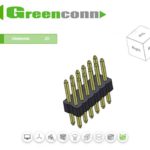Five Key Characteristics of Military-Grade Composite Cable Clamps
Today’s high-performance composite materials make it easy to dispel the misconception that composite cable clamps are inferior to metal clamps in high-reliability, harsh environment applications. Consider these five factors to select the appropriate composite clamps for your most demanding applications.
By Matthew Noce, Military & Aerospace Market Manager; Mathieu Desjardins, Senior Design Engineer; Lauren Toye-O’Donnell, Product Specialist, Amphenol Pcd cable clamps
High-strength composite cable clamps are just as strong as metal clamps, offer significant weight and installation time savings, and exceed expectations when sourced from a trusted supplier. To identify the best composite cable clamps for harsh-environment and military applications, evaluate the options in terms of these five key characteristics: performance, weight, ease of use, durability, and reliability.
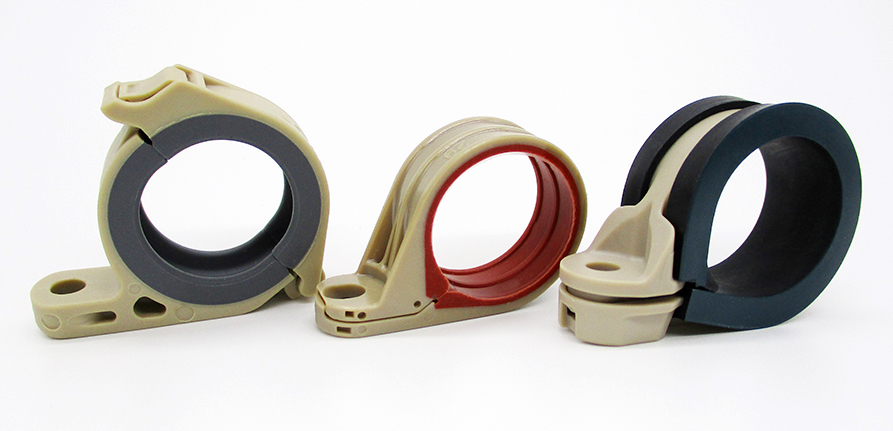
Amphenol’s CC5516 Series composite cable clamps are lighter weight than standard metal clamps, meet or exceed rigorous mil-spec testing requirements, and offer a wide selection of materials to ensure rugged performance in all harsh environments.
1. Performance
Many people believe that composite clamps are not as strong as metal clamps and will not meet the high performance demands of harsh military environments, including vibration, static loads, flight loads, and strength. However, industry-standard testing requirements can be used as a guide to validate that composite clamps can meet or even exceed metal clamp performance in harsh-environment conditions. Some of the many military and aerospace industry standards that can be used to verify the high-performance capabilities of composite cable clamps include MS21919, MS23190, MIL-DTL-85052, and RTCA DO-160G.
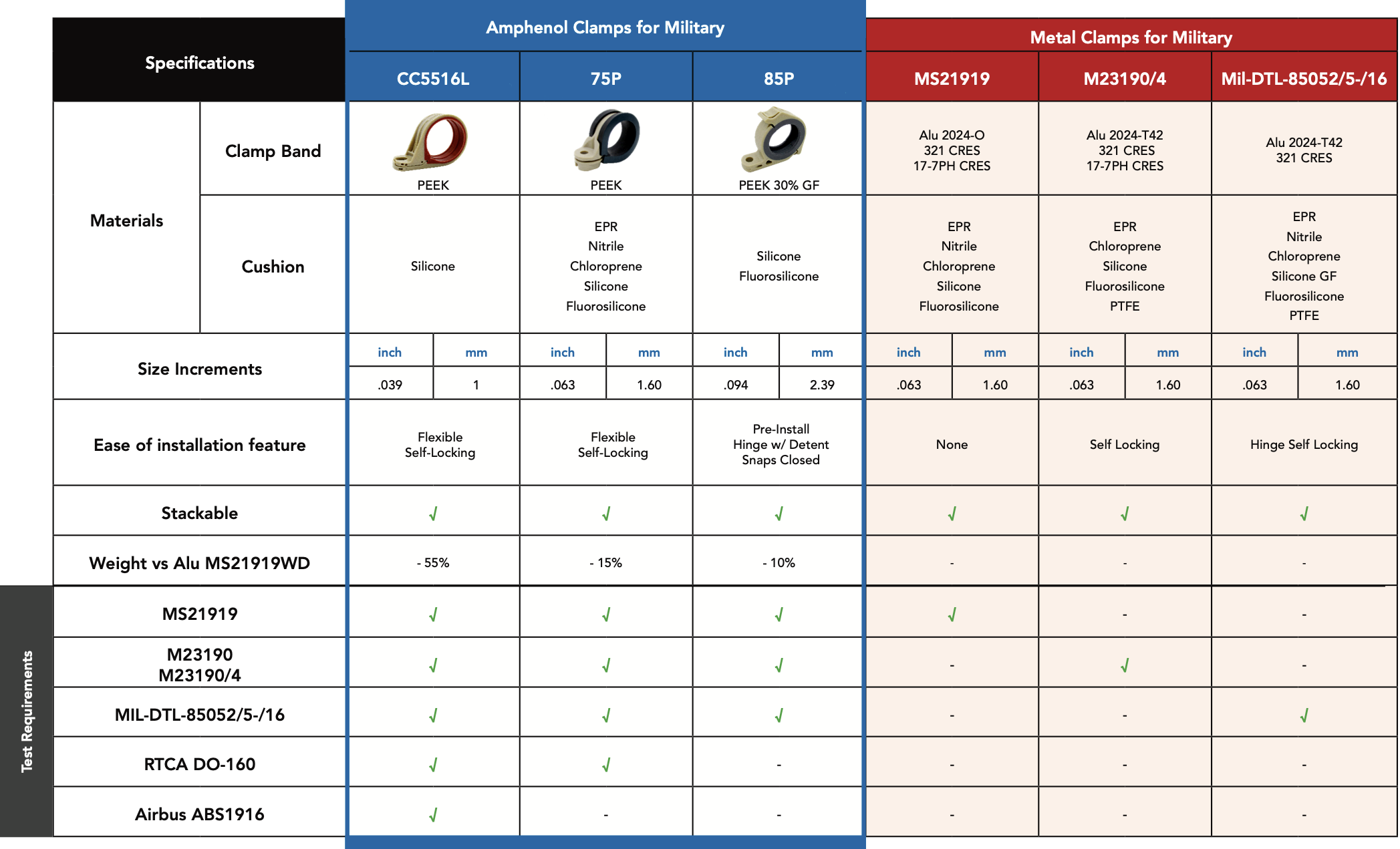
Amphenol’s tested its military-grade composite cable clamps (left/blue) against mil-spec requirements. This matrix reveals that they are not only lighter weight but also meet or exceed metal clamp performance (right/red), validating their high-performance, military-grade capabilities in harsh environments.
Vibration – Standardized vibration tests can be used to compare and validate composite cable clamp performance relative to traditional metal clamps. Some industry standards, such as MIL-DTL-85052 or MS23190/4, define dimensions and layouts for installing metal mandrels in clamps, which are then subjected to predetermined random or sinusoidal vibration levels and durations. MS23190 also defines a layout for composite cable clamps with a specific bundle construction and wire type instead of rigid mandrels. While not necessarily representative of actual aircraft installations, these tests provide quick, easy, and effective verification of the claim that composite clamps can indeed meet or even exceed the fatigue performance of industry-standard metal clamps.
Another method for verifying the vibration performance characteristics of a clamp is to reproduce an aircraft’s typical installation in terms of clamp spacing and bundle masses and then subject the resulting layout to standard vibration levels and durations, such as those found in RTCA DO-160G for electrical equipment.
Static and Flight Loads – A clamp must be able to reliably support both static and flight loads. Static loads involve supporting the mass of the cable bundle during installation and general handling processes. A typical handling load requirement is 50 pounds. MS23190 defines 50 pounds as the minimum strength requirement for composite cable clamps to ensure operational success. Flight loads are the result of the bundle’s mass exerting forces on the clamp as the aircraft accelerates and maneuvers. Flight loads can be calculated by multiplying the wire mass being supported (e.g., 50lbs) with the expected acceleration force (e.g., 8g) as defined by the end user. The RTCA DO-160G standard, for example, requires clamps to support a sustained acceleration of 9g for three seconds. Since smaller clamps support lighter, smaller-diameter bundles, their flight loads are typically much lower than the standard 50-pound handling load. Similarly, since larger clamps support heavier, larger-diameter bundles, their flights loads can be much higher than the standard 50-pound handling load. In these cases, specifiers should consider both the wire mass and individual application parameters, like g-force, to ensure that selected clamps will reliably provide the required amount of strength.
Strength – Cable clamp strength can be verified in the horizontal and vertical axes, and diagonal directions should be considered when they are determined to be more severe for the clamp than purely horizontal or vertical loading. The weakest direction for a clamp is the one that places the applied load vector furthest away from its mounting legs, which is the most typical failure location.
In addition to being tested at room temperature, the strength of a clamp should also be tested at both the lower and higher ends of an application’s temperature range. Lower temperatures typically result in brittleness and loss of ductility in composite clamps, while higher temperatures tend to result in a reduced stiffness and increased ductility. As such, it’s wise to inspect composite clamps for permanent deformation after they are tested to their required load in both low and high temperatures.
2. Weight
Switching to cable clamps made from composite materials can provide up to 55% weight savings compared to metal clamps, which can be especially beneficial in aerospace applications. Lightweight clamps contribute to more fuel-efficient aircraft, which can enable cost savings and reduce environmental impact, and increase allowances for additional payloads or system add-ons. For example, every 100 pounds (45kg) saved by switching from metal to composite clamps in aircraft applications can generate up to $10,000 in annual fuel savings and significantly decrease CO2 emissions.
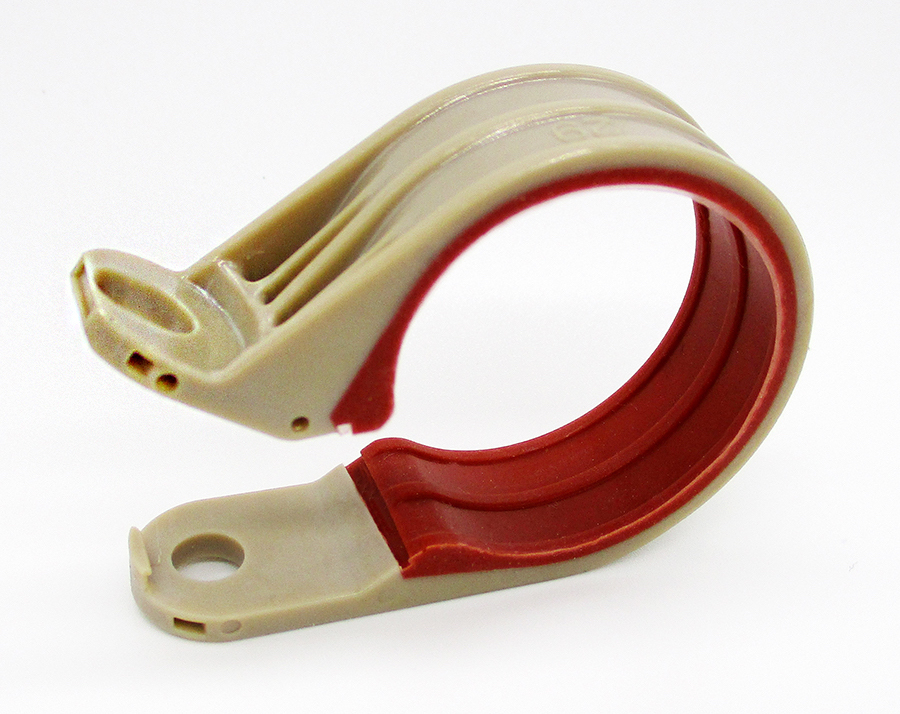
Designed to keep cable harnesses or hydraulic pipes securely maintained on a structure, Amphenol’s CC5516L Series is lightweight line of composite cable clamps that provides up to 55% weight savings compared to standard metal clamps.
Composite clamps made of polyetheretherketone (PEEK) are ideal for harsh-environment aerospace applications with a high strength-to-weight ratio. PEEK is lightweight, non-conductive, and chemically inert, and is available in multiple grades designed to perform in a broad range of temperatures. Some PEEK material compositions can even support applications up to 260°C (500°F). As such, lightweight PEEK cable clamps have been successfully used to replace steel and aluminum clamps in a number of commercial aerospace applications and are experiencing increasing rates of adoption in the military aerospace market as well.
3. Ease of Use
Aircraft designs are evolving and incorporating a variety of new system add-ons but are still subject to the same space and weight constraints. This is putting increased scrutiny on the wire and harness installation assembly process and incentivizing efforts to decrease installation time and weight. As such, ease-of-use in terms of cabling installation and maintenance is rapidly rising to the critical importance of space and weight savings in these applications.
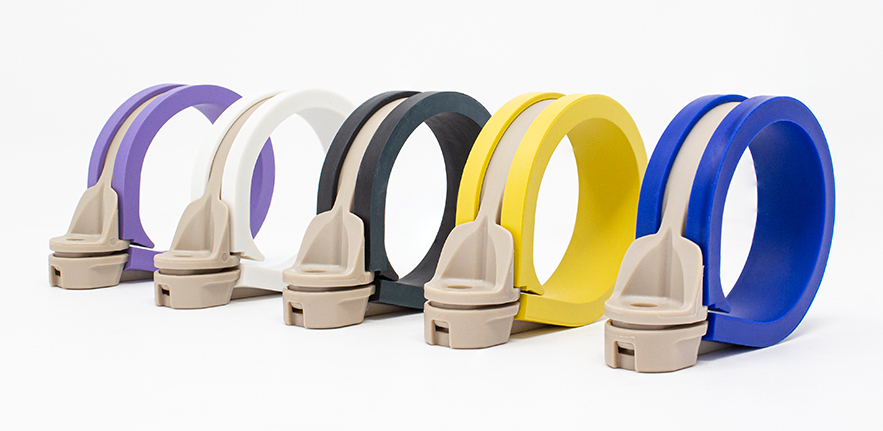
Cushions for Amphenol Pcd’s 75P Clamp are available in a wide variety of rubber materials, including ethylene propylene, nitrile, chloroprene, silicone, and fluorosilicone, to satisfy a wide range of application demands. They are also available in the same cushion profiles, materials, and color-codings as industry-standard metal clamps for maximum compatibility with any application and environment.
Space and weight constraints in aircraft and other applications also make the cabling installation process increasingly difficult, as these components are often utilized in hard-to-reach or visually obscured areas. This becomes an especially challenging hurdle when considering the labor-intensive installation process for metal clamps, which often requires two hands to physically bend and shape the clamp both open and closed around the cable bundle. In addition, the required reshaping of metal clamps can lead to the misalignment of mounting holes, making it even more difficult to hold the clamp in a closed position and install a fastener at the same time. Such difficulties can contribute to repetitive strain injuries in installers and the scrapping of metal cable clamps that cannot be aligned and reshaped can make the repositioning of harness bundles more difficult and time-consuming. To address this scenario, some OEMs have developed custom tools to aid in the metal clamp installation process but, while potentially helpful, this approach adds cost to the build.
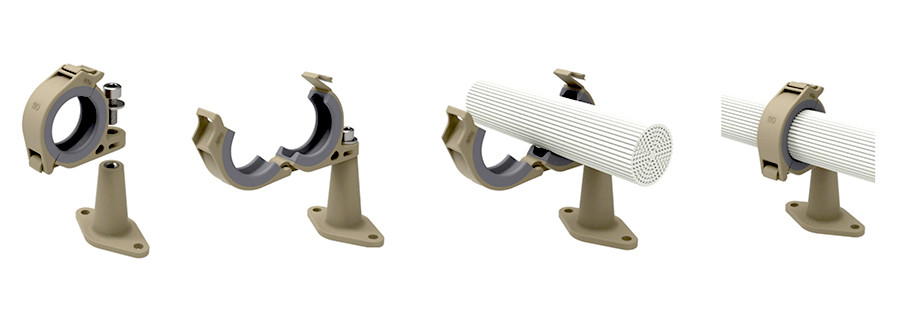
Amphenol Pcd’s 85P Clamp is a pre-mountable clamp that supports tool-free harness installation and has a bottom hinge for faster installation.
Cable clamps should be ergonomic and easy for installers to use. Clamps that integrate clear and concise labeling and color-coding features allow installers to quickly identify correct clamp types and sizes, which cuts down on installation time and mitigates risk. Additionally, clamps with shape-retaining spring-back opening and alignment features allow installers to secure clamps with one hand and, if combined with a self-locking feature, free up both hands for fastener installation. These features create a highly functional ergonomic design that reduces repetitive strain injuries, achieves production time and labor cost savings, and minimizes foreign object debris (FOD) and scrap.
4. Durability
Military and aerospace applications operate in a variety of harsh environments and require cable clamps that are durable, adaptable, and rugged. To ensure that composite cable clamps meet the demanding requirements of such harsh environments, consider the following testing scenarios.
Environmental – Wire harness clamps sustain a variety of environmental conditions throughout the lifetime of an aircraft, including varying temperature extremes, humidity levels, and exposure to harsh chemicals. Several types of accelerated aging tests can ensure that composite clamps will survive those harsh conditions and perform over the life of the aircraft or for up to 15 years, depending on the cushion material. For example, specific test conditions for humidity aging, temperature cycling, and dry aging can be found in MS23190 and RTCA DO-160G. These varying test conditions can either be performed individually or one after the other, as a sequence, to test their combined effects. In addition, following accelerated aging testing with static load testing or other mechanical testing procedures can further verify and enable even more accurate comparisons of composite clamp performance in harsh-environment applications.
Chemical Resistance – Testing can also ensure that composite cable clamps will not deteriorate if exposed, accidentally or through normal operation, to harsh chemicals such as Skydrol, jet fuel, deicing fluids, and solvents. Lists of chemicals and methods for exposing clamps can be found in both MS23190 and RTCA DO-160G, but end users should ensure that all harsh fluids used in the operation of the aircraft or other application are considered. Again, following chemical testing with mechanical testing procedures will further confirm the performance capabilities of composite clamps in harsh environments.
Numerous other performance requirements, such as flammability, fungus, UV, and ozone resistance, are inherent to the material from which clamps are constructed and can often be verified by testing material coupons that are representative of clamp construction. Requirements meant to test for corrosion, like salt fog, can be disregarded if the composite clamp is free of metallic components and thus not susceptible to corrosion.
Completing a robust test plan on composite clamps is a crucial step in demonstrating compliance and providing confidence that composite clamps are suitable and durable enough to reliably perform in and withstand the rigors of military and aerospace applications.
5. Reliability
To mitigate risk, it’s advisable to utilize reliable suppliers with a proven track record of supporting military programs and delivering product at the level of scrutiny that the military market requires. Using AS9100-approved suppliers can further ensure that the highest quality and reliability standards are in place. It is also important to consider suppliers with lean manufacturing practices, as they can offer competitive lead times and quality-assured results due to reduced production waste in the sense of both physical waste and time effectiveness. Above and beyond these factors, specifiers should select a supplier that invests in constant improvements via lean systems training, process improvement plans, and green initiatives that ensure that efficiency is continuously being optimized to meet market demands.

Amphenol Pcd, located in Beverly, Massachusetts, is a lean manufacturing facility with a strong history of providing the military and aerospace markets with an array of high-performance connectivity products, including more than 4,000,000 clamps per year.
Conclusion
High-performance composite clamps from trusted suppliers can provide lightweight, robust, and user-friendly cable management solutions proven to meet or exceed rigorous military testing requirements and ideal for use in harsh environments. Clamps made of composite materials like PEEK can achieve weight savings of up to 55% compared to metal clamps, enabling better fuel efficiency and allowing for additional payload and system add-ons. Additionally, those with self-locking mechanisms and other ease-of-use features can reduce installation time and the risk of damage, FOD, and scrap. When evaluating composite clamp options, it’s important to match performance, weight, ease of use, durability, and reliability characteristics with the application at hand and to source from a lean manufacturing facility with a strong reputation in the military and aerospace market.
For more information, visit Amphenol Pcd online.



